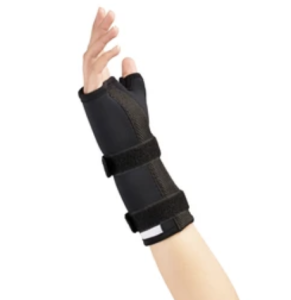Triangular Fibrocartilage Complex (TFCC) Injury
The TFCC is a combination of ligament, tendon and cartilage and therefore name as Triangular Fibrocartilage complex. This ligament has a major function of stabilizing and supporting the wrist. It is an important structure connecting the forearm bones to the small bones in wrist, thereby giving you the mobility when you grip object tightly or rotate the wrist. The TFCC provides these movement more support and range while behaving as cushion in the area.
What causes TFCC strain or tear?
There are two ways your TFCC can give up – either due to injury or any degeneration of these ligament.
- Injury – most often when you fall on outstretched hand is a common precursor of the TFCC injury or tear. The mechanism could be a sudden impact or a twisting injury. Older adults are more vulnerable as there can be thinning of these ligaments with age and making it easy to injure. If there has been a fracture of forearm or wrist, this can directly impact the TFCC. Overuse activities or repetitive movement can cause the area to injure.
- Degeneration – as any structure in your body, this too can get thinner with wear and tear of aging. There can be a chronic tear which is gradually occurring over time.
Symptoms
Injury to TFCC can cause following symptoms
- Pain and tenderness on wrist area mainly outside of wrist
- Difficulty in rotating wrist or forearm with clicks or pops sometimes
- Reduced strength in wrist with weak grip strength
Diagnosis and Tests
Early intervention is important, before the weakness takes over and causes atrophy. Upon your first meet with Physiotherapist, they will ask for the pain and medical history to know how it started. The next step is physical exam with few tests of the ligament and muscles to confirm the involvement of the TFCC. Followed by this, upon pressing different areas in wrist there will be determination of amount and intensity of the issue. The range of motion is tested again to see how far the involved area is affected.
TFCC tests can be diagnosed with fovea test where the provider applies pressure to outside o wrist for tenderness. This is often compared to other side for confirmation.
Your provider may also recommend imaging tests — such as X-rays or MRI — to look for fractures or tears.
Treatment for TFCC
After a TFCC injury you may find difficulties in doing daily activities. In such scenario your provider may recommend one or more from below-
- The doctor may prescribe some anti-inflammatory to help reduce swelling as well as may reduce some pain.
- Bracing of wrist to prevent from further damage so it can be protected can be important during acute/initial phase. The 3pp carpal lift brace are generally prescribed in initial acute phase to support the wrist small bones. It has cushion on base to stabilize the wrist.
- Physiotherapist may also with it do manual therapy and exercises to strengthen the muscles around wrist joint.
- Remember to ice everyday 10 minutes at a time in initial week and move on to heat as per your physiotherapist’s advice. The therapist can use Taping.
- Surgery: If more conservative treatments don’t provide relief, your provider may recommend surgery. In most cases, minimally invasive arthroscopic surgery can repair TFCC tears. Following a surgery, few step to be mindful of are, make sure you keep your wound dry. Follow up with surgeon as suggested – after 2 weeks and then after 2 months. Physiotherapy sessions 2-3 times a week for 8 weeks and follow the home exercise programme as prescribed by the physiotherapist.
Preventing TFCC
There are few ways to prevent it from getting injured, as mentioned below,
- Avoid repetitive, high-impact activities using the hands
- Do warmup exercises before a sport or activity that involves twisting your arm or wrist (like playing tennis or baseball).
- Strengthen your wrist and forearm muscles
- Gradually increase any athletic activity, rather than suddenly increasing the activity amount or intensity.
Prognosis
Most of the injuries and tears can take up to 12 weeks due to the sensitive location and the nature of the structure. But be mindful to call the doctor, if there is any swelling, discoloration or loud pops heard.
In most of scenarios, during initial phase it is advised not to do any training, lifting or gymnastics. It is known to heal faster when wrist is rested in neutral position. Furthermore, you can return to these activities in 3-4 months based on the extent of injury. It is always advised to review with your physiotherapist before returning to any heavy weight exercise or work.
Need Some Help?
If you think you have Triangular Fibrocartilage Complex or have been diagnosed with it rest assured that there is help book. We have many experienced Registered Physiotherapists at PhysioNow who would love to help you out. Book with us at PhysioNow today for your initial assessment and treatment.




Leave a Reply